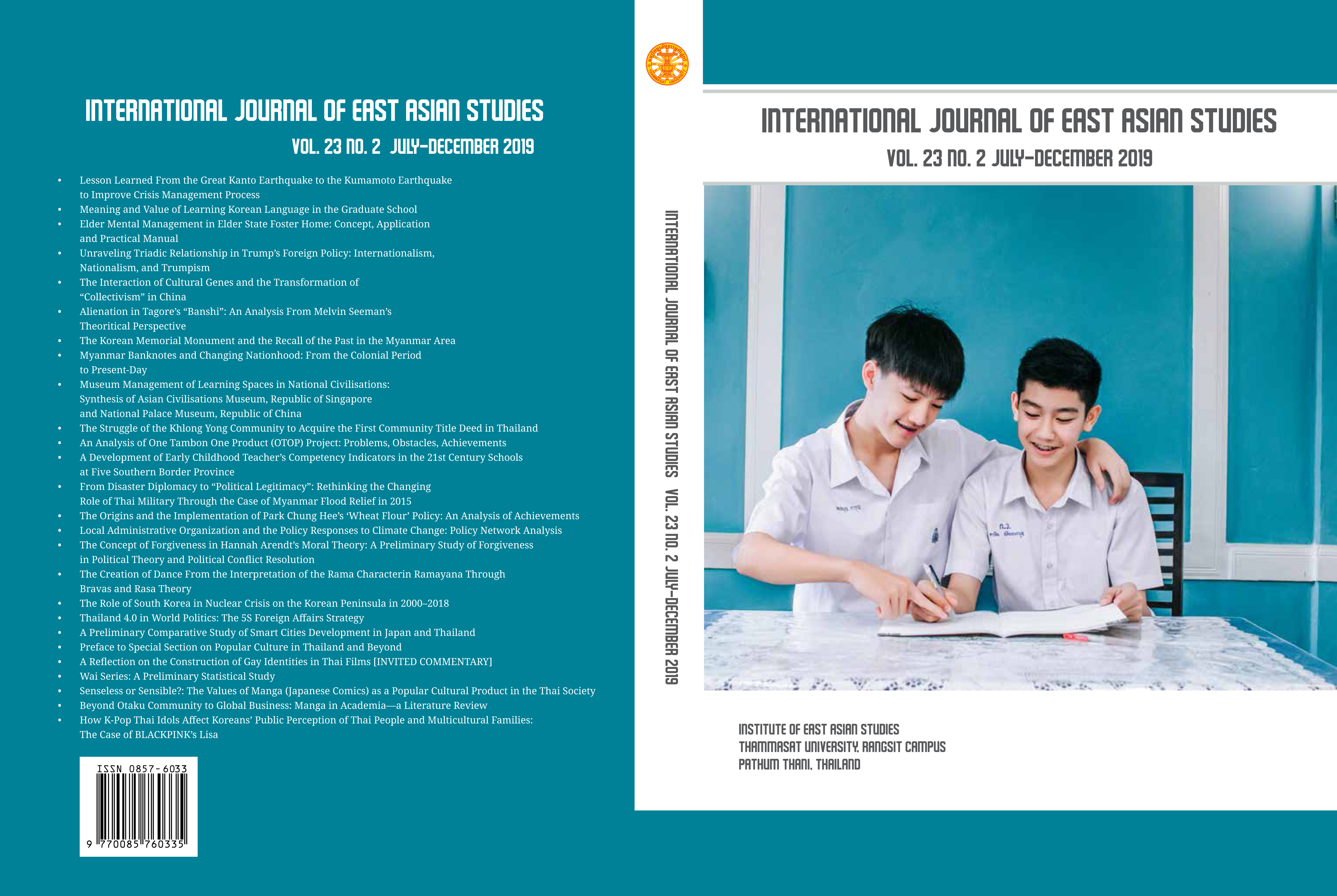Myanmar Banknotes and Changing Nationhood: From the Colonial Period to Present-Day
Keywords:
Mynamar banknotes, Myanmar government, colony, nationhood, political ideologyAbstract
Banknotes were the otherness in Myanmar society in the colonial years. This was due to the fact that the country had no legal system that recognized note printing works and the status of such notes. Also, it had no banking system circulating notes in the country's economic activities. However, as paper money was introduced in the country, banknotes were not simply a means of economic exchanges as the notes contained letters, pictures and symbols. Therefore, they were actually a form of political communication between those who printed them and people in the society. The designs of Myanmar banknotes were changing throughout the history. These changes reflected the efforts of governments at different points in time in promoting their own versions of the nationhood. Although the changes in Myanmar banknotes' design might not instantly follow political transitions due to several factors such as the country's limited economic capacity, it did correspond to changing laws and political ideologies as well as to the beliefs of the populous. The efforts to redesign banknotes sometimes played a role in triggering protests from the Burmese.
Downloads
References
Anderson, B. R. O. G. (2016). Imagined communities: Reflections on the origin and spread of nationalism. London: Verso.
ATSnotes. (n.d.). Burma paper money catalog and Burman currency history. Retrieved from http://www.atsnotes.com/catalog/banknotes/burma.html
Bagchi, A. K. (1997). The Evolution of the State Bank of India: The era of the presidency banks, 1876-1920. New Delhi: State Bank of India and Sage Publications.
Banknote Index. (n.d.). India Series A Banknotes. Retrieved from https://banknoteindex.com/articles/India_Series_A/India_Series_A.mhtml.
Banknote Index. (n.d.). Burma Series A Banknotes. Retrieved from https://banknoteindex.com/browse.mhtml?browseBy=Country&browse=Burma
Central Bank of Myanmar. (n.d.). Series of Bank Notes and Coins. Retrieved from Central Bank of Myanmar website: https://cbm.gov.mm/content/series-bank-notes-and-coins
Charney, M. W., & Naono, A. (January 01, 2015). The Burmese Economy under the Japanese Occupation, 1942-1945. Economies Under Occupation : the Hegemony of Nazi Germany and Imperial Japan in World War Ii, 218-231.
Cheesman, N. (2002). Legitimising the union of Myanmar through primary school textbooks. University of Western Australia.
Government of Burma. (n.d.). Government of Burma Law No. 45/1946 - THE CURRENCY AND COINAGE ACT. Retrieved from https://www.burmalibrary. org/sites/burmalibrary.org/files/obl/docs25/1946_12_20_Government_of_Burma_Act_No.%2845%29_en.pdf
Hobsbawm, E. J., & Ranger, T. O. (2017). The Invention of tradition. New York: Cambridge University Press.
Houtman, G. (1999). Remaking Myanmar and human origins. Leiden: Royal Institute of Linguistics and Anthropology.
Houtman, G. (1999). Mental culture in Burmese crisis politics: Aung San Suu Kyi and the
National League for Democracy. Tokyo: Inst. for the Study of Languages and Cultures
of Asia and Africa, Tokyo Univ. of Foreign Studies.
Htin, A. (1965). The Stricken Peacock. Anglo-Burmese relations, 1752-1948. Pp. xii. 135. Martinus Nijhoff: The Hague.
Kyan, Daw (1979). “The Peacock Coins” Researches in Burmese History No.3. 145-153
Orbell, J., Turton, A., & Pressnell, L. S. (2017). British banking: A guide to historical records. Abingdon, Oxon: Routledge.
Renan, E., & Giglioli, M. F. N. (2018). What is a nation?: And other political writings. New York: Columbia University Press
Reserve Bank of Indea. (n.d.). Reserve Bank of India Act. Retrieved from http://rbidocs.rbi.org.in/rdocs/Publications/PDFs/RBIAM_230609.pdf
Salem-Gervais, N., & Metro, R. (January 01, 2012). A Textbook Case of Nation-Building: The Evolution of History Curricula in Myanmar. Journal of Burma Studies, 16, 1, 27-78.
Seekins, D. M. (2015). State and society in modern Rangoon. London: Routledge.
Soe, T. (2013). Financial development in Myanmar. Yangon: Yan Aung Literature.
Taylor, R. H., & Taylor, R. H. (2009). The state in Myanmar. London: Hurst.
The Union of Burma. (n.d.). The Constitution of the Union of Burma, 1947. Retrieved from https://www.ilo.org/dyn/natlex/docs/ELECTRONIC/79573/ 85699/F1436085708/MMR79573.pdf
The Union Bank of Burma. (n.d.). the Union Bank of Burma. Act, 1952. Retrieved from https://www.burmalibrary.org/docs24/1952_04_09_THE_UNION_BANK_ OF_BURiMA_ACT_No.(9)_en.pdf
Turnell, S., & Nordisk Institut for Asienstudier. (2009). Fiery dragons: Banks, moneylenders and microfinance in Burma. Copenhagen: NIAS Press.
Union Bank of Burma. (n.d.). Union Bank of Burma Act 1952. Retrieved from https://www.burmalibrary.org/docs24/1952_04_09_THE_UNION_BANK_OF_\
BURiMA_ACT_No.(9)_en.pdf
Zar Ni (1998). Knowledge, control, and power: the politics of education under Burma’s military dictatorship (1962–88) (Doctoral dissertation, University of Wisconsin-Madison).
Translated Burmese References
Ministry of Education Myanmar (2008). Myanmar Dictionary. Yangon, Myanmar: Ministry of Education Myanmar.
Ministry of Education Myanmar (2012). Myanmar reading grade 3. NayPyiTaw, Myanmar: Ministry of Education Myanmar.
Myanmar Naing Ngan Bar Thar Pyan Sar Sar Pay A Thin. (1975). Myanma Swal Sone Kyan Ta Twel 1(Ka). Yangon. Sar Pay Bait Man.
Myanmar Naing Ngan Bar Thar Pyan Sar Sar Pay A Thin. (1975). Myanma Swal Sone Kyan Ta Twel 2(Kha). Yangon. Sar Pay Bait Man.
Myanmar Naing Ngan Bar Thar Pyan Sar Sar Pay A Thin. (1975). Myanma Swal Sone Kyan Ta Twel 4(Ka). Yangon. Sar Pay Bait Man.
Myanmar Naing Ngan Bar Thar Pyan Sar Sar Pay A Thin. (1975). Myanma Swal Sone Kyan Ta Twel 9(Ka). Yangon. Sar Pay Bait Man.
Myanmar Naing Ngan Bar Thar Pyan Sar Sar Pay A Thin. (1975). Myanma Swal Sone Kyan Ta Twel 14. Yangon. Sar Pay Bait Man.
Saungders Weaving Institute (2014). Saungders Weaving Institute 100 years. Mandalay: Saungders Weaving Institute.
Saw Mone Nyin. (1982). Yadanar Mon Ma Ga Zin : Myanmar Nik Chin Tay. 45-51.



